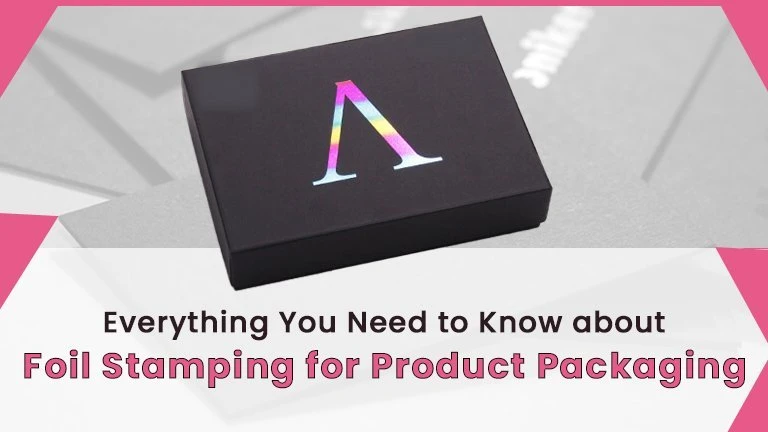Table of Contents
Introduction to Traditional Foil Stamping Process
Foil stamping utilizes the principle of heat and pressure transfer to imprint the aluminum layer from a foil onto the surface of a substrate, creating a unique metallic effect. As the primary material used in foil stamping is aluminum foil, it is often referred to as hot foil stamping.
Aluminum foil typically consists of multiple layers of materials, with the base material commonly being PE, followed by a release coating, color coating, metal coating (aluminum plating), and adhesive coating.
In the printing industry, foil stamping onto paper is commonly referred to as foil stamping. Foil stamping does not necessarily mean that the stamped material is gold. There are many types of foil stamping materials, including gold, silver, holographic gold, holographic silver, black, red, green, and many more.
Product Applications
Common gold and holographic gold stamping are versatile techniques suitable for a wide range of products, including gold cards, silver cards, holographic cards, and glass cards. These methods are commonly used in various industries due to their widespread application.
Positioning holographic stamping is a specialized design application that utilizes holographic aluminum foil with specific anti-counterfeit patterns. This feature significantly enhances the product’s anti-counterfeit capabilities and adds a touch of sophistication. While domestically produced holographic foil is more cost-effective than imported alternatives, it may have slightly lower stamping performance. Proper control of stamping parameters such as temperature, pressure, speed, and machine type is crucial for achieving optimal results with holographic aluminum foil stamping.
Specialized applications of aluminum foil in the stamping process, especially in pre-printing stages, represent innovative approaches in industries like cigarette label design. These processes demand precise positioning, smooth surfaces, uniform pressure distribution, and excellent adhesion of the stamped foil to printing surfaces. It’s essential to avoid visible pressure marks along pattern edges, ensure good adhesion, and prevent scratches or scuffs. Protecting semi-finished products like white cards and glass cards during stamping minimizes deformities, streamlining post-stamping processes and improving product quality.
Craft Features
High image quality: Images transferred through foil stamping technology have sharp edges, high clarity, and a smooth and glossy surface. This technique is particularly suitable for cosmetics or high-end packaging products with high requirements for fine stamping.
High glossiness: The stamped patterns are bright, smooth, and have a high surface gloss, adding a premium feel to the products.
Wide range of foil selection: Different colors or gloss effects of stamping foils can be selected, as well as foils suitable for different substrates, giving paper foil stamping a great deal of flexibility to meet various design needs.
Can perform embossed stamping: Embossed stamping involves using stamping plates and dies under certain pressure and temperature to cause plastic deformation of the substrate, while also causing plastic deformation of the areas where the aluminum foil is transferred onto the printed material or other substrates. Since this process combines stamping and embossing in one step, the quality standards for stamping plates are higher, the requirements for plate making are stricter, and the process is more complex.
Anti-counterfeit effect of holographic stamping foils: The use of holographic stamping foils can achieve holographic patterns, giving printed materials better anti-counterfeit effects. The biggest difference between holographic stamping foils and ordinary aluminum foils in structure is the presence of a grating structure in the transfer layer.
Introduction to Cold Foil Stamping Technology
Cold foil stamping technology is a recent high-tech achievement in the printing industry in Europe and America. It breaks away from the traditional hot foil stamping process, which relies on heat and pressure to transfer metallized foil, and instead uses a new concept – cold pressure technology to transfer the metallized foil. Cold foil stamping not only solves many process problems that have been difficult to address in the printing industry but also, more importantly, saves energy and avoids the pollution caused to the environment during the production of metal plates.
When applying cold foil stamping technology to narrow web rotary printing machines for printing pressure-sensitive adhesive materials, only a few additional devices need to be added to the existing equipment. The following introduces the process principle and additional equipment of cold foil stamping.
Principle of Cold Foil Stamping
The traditional foil stamping process uses metallized aluminum foil with a pre-coated heat-activated adhesive on the back. During foil stamping, the pressure from a hot roller melts the adhesive, enabling the transfer of the aluminum foil.
The cold foil stamping process uses a special type of metallized aluminum foil that does not have adhesive pre-coated on the back. Instead, adhesive is applied directly onto the areas where decoration is needed during printing. When transferring, the metallized aluminum foil comes into contact with the adhesive, and under the action of the adhesive, adheres to the surface of the printed material.
The cold foil stamping process is as follows: first, print UV ink. After drying, print special adhesive – UV curable adhesive – on the surface of the ink where foil stamping is needed. Then, use a UV drying device to remove the moisture from the adhesive to a certain extent, forming a layer of high-viscosity, very thin pressure-sensitive adhesive. Next, begin cold foil stamping, where a pair of metal rollers bring the aluminum foil into contact with the adhesive and press it into one. Since the adhesive has a strong bonding force with the aluminum foil, during waste removal, the parts of the aluminum foil that come into contact with the adhesive remain on the surface of the printed material, becoming integrated with the print, while the other parts of the aluminum foil are discarded like traditional foil stamping waste, thereby completing the first part of the foil stamping process.
Since the transferred foil patterns on the printed material surface are floating, they have poor adhesion and must be protected. Apply gloss or laminate on the surface of the printed material to protect the foil patterns.
Finally, perform post-printing processes such as die-cutting, waste removal, sheet cutting, or rewinding, completing the entire pressure-sensitive adhesive printing process, similar to regular pressure-sensitive adhesive post-processing.
Additional Equipment
The printing plate for printing cold foil adhesive uses DuPont Cyrel plates. The printed adhesive is dried in an additional UV device to form a high-adhesive area on the surface of the printed material where foil stamping is needed. A set of metal embossing rollers is used to firmly bond the aluminum foil to the surface of the printed pattern through pressure, achieving cold foil stamping.
Process Features
No heating required: This is the most significant feature of cold foil stamping technology. Unlike traditional hot foil stamping processes, cold foil stamping does not require heating during the process, hence the name “cold foil stamping.” This process achieves foil stamping effects by using specialized glue (ink) to adhere parts of the cold foil, excluding the base layer, to the substrate’s surface.
High precision: Cold foil stamping has high resolution, essentially reaching printing resolution. Whether stamping fine dots and lines or achieving embossed effects, its performance is excellent. This makes cold foil stamping suitable for paper products that require high-precision foil stamping.
Large area stamping: Hot foil stamping is generally only suitable for stamping small areas such as trademarks and logos, while cold foil stamping foils have a larger width, even comparable to the width of the printing machine, making them more suitable for large area stamping of graphics and text. This gives cold foil stamping a clear advantage in paper products that require large area stamping.
Wide applicability: Cold foil stamping can transfer cold foil by relying on the action of adhesive and pressure at room temperature, without the need for special adjustment and control of stamping temperature like hot foil stamping. This makes cold foil stamping suitable for more substrates, such as paper, cardboard, and film.
Environmental friendly: Compared to traditional hot foil stamping processes, cold foil stamping processes do not require the use of large amounts of chemicals, making them more environmentally friendly. At the same time, since cold foil stamping does not require the production of expensive metal stamping plates, it also avoids the pollution caused to the environment during the plate-making process in hot foil stamping.
Easy to achieve stamp-first-then-print: In the stamp-first-then-print process, cold foil stamping has low operation difficulty, high efficiency, and low reject rates. This gives cold foil stamping a clear advantage in paper products that require stamping first and then printing.
Paper cold foil stamping technology can also achieve high-definition, high-color reproduction, and high gloss printing effects, while also having advantages such as waterproof, abrasion-resistant, and UV-resistant. These characteristics make paper cold foil stamping technology widely applicable in the packaging printing field.
Comparison between Cold Foil Stamping and Traditional Hot Foil Stamping Processes
Processing Method
Cold Foil Process: Uses specialized glue (ink) to adhere parts of the cold foil, excluding the base layer, to the substrate’s surface to achieve foil stamping effects. Hot Foil Process: Heats the material and presses it onto the surface of the printed product to achieve image transfer.
Processing Temperature: Cold Foil Process: Achieves cold foil transfer by relying on adhesive and pressure at room temperature, without the need for heating. Hot Foil Process: Requires heating to a certain temperature for processing, usually requiring the use of specialized hot stamping machines.
Cost
Cold Foil Process: Lower plate-making costs, as there is no need to create expensive metal stamping plates like in hot foil stamping, and avoids the pollution caused during plate making.
Hot Foil Process: Due to the need for hot stamping machines for processing, the processing cost is relatively higher.
Stamping Precision
Cold Foil Process: High resolution, excellent for stamping fine dots, lines, and achieving embossed effects.
Hot Foil Process: Also has high stamping precision, but may be slightly lower compared to cold foil stamping.
Stamping Area
Cold Foil Process: Cold foil has a wider width, even comparable to the width of the printing machine, making it more suitable for large area stamping.
Hot Foil Process: Generally more suitable for stamping small areas such as trademarks and logos.
Substrate Applicability
Cold Foil Process: Has a wider range of applicable substrates, such as paper, cardboard, and film.
Hot Foil Process: Relatively limited in substrate applicability.
Adhesion Strength
Cold Foil Process: Adhesion strength may be slightly lower than hot foil stamping because cold foil stamping relies on adhesive and pressure.
Hot Foil Process: The use of hot stamping machines during processing allows for better bonding between the material and the surface of the printed product, resulting in higher adhesion strength.
Environmental Friendliness
Cold Foil Process: Does not use large quantities of chemical substances, making it more environmentally friendly.
Hot Foil Process: Due to the need for heating and potential use of chemical substances, its environmental friendliness may be slightly inferior to cold foil process.
Printing Effects
Cold Foil Process: Can achieve high definition, high color fidelity, and high gloss printing effects, while also offering advantages such as waterproofing, abrasion resistance, and UV protection.
Hot Foil Process: Can also achieve high-quality printing effects, but may be slightly inferior to cold foil process in certain aspects.
There are significant differences between paper cold foil stamping and hot foil stamping processes in terms of processing methods, processing temperatures, costs, stamping precision, stamping area, substrate applicability, adhesion strength, environmental friendliness, and printing effects. The choice of which process to use depends on specific printing needs and requirements.
Choosing the right foil stamping solution can help create beautiful and unique results, allowing your project to stand out from the crowd. With the right equipment and expertise, you can achieve remarkable results regardless of which process you choose. If you’re still unsure about which process to choose for your product and design, our team can provide professional guidance and timely support.

















